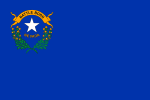Ice Age Fossils State Park
2017 establishments in NevadaPaleontology in NevadaProtected areas established in 2017Protected areas of Clark County, NevadaState parks of Nevada ... and 1 more
Use mdy dates from August 2023
Ice Age Fossils State Park is a 315-acre state park in North Las Vegas, Nevada, United States, on the northernmost fringe of the metropolitan area. It is located adjacent to the Tule Springs Fossil Beds National Monument near Willie McCool Regional Park. The park saw its grand opening on January 20, 2024.
Excerpt from the Wikipedia article Ice Age Fossils State Park (License: CC BY-SA 3.0, Authors).Ice Age Fossils State Park
North Decatur Boulevard, Las Vegas
Geographical coordinates (GPS) Address Nearby Places Show on map
Geographical coordinates (GPS)
| Latitude | Longitude |
|---|---|
| N 36.318611111111 ° | E -115.20611111111 ° |
Address
North Decatur Boulevard
89085 Las Vegas
Nevada, United States
Open on Google Maps





